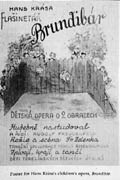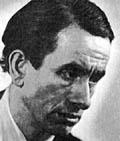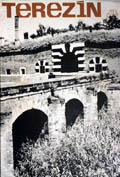|
Hans Krása’s Brundibár, and the Surreal Cultural Life of Theresienstadt
The Saint Paul Chamber Orchestra January 4 program combines two rather disparate compositions for voices and orchestra or chamber ensemble. Mozart's Requiem Mass, left unfinished at the time of his death in 1791, represents the pinnacle of the large-scale mass for soloists, mixed chorus, and orchestra in the 18th century Viennese classical tradition. Hans Krása's Brundibár is a short children's opera, written first in 1938 and revised in the Nazi transit camp, Terezín (or Theresienstadt in German), for children's choir with ten solo vocal roles and a chamber ensemble of strings, percussion, piano, and guitar. A considerable gulf of time and style separate these pieces, but the gulf is not as wide as one might first think.
Both these pieces were written under very trying circumstances. Mozart struggled to complete the commission for a requiem mass he had from a nobleman as he faced his own collapsing health and the most desperate financial circumstances for his family. Krása was a gifted Czech composer of Jewish origin who was born in Prague in 1899. He wrote the first version of Brundibár along with the writer Adolf Hoffmeister in 1938 for a children's opera competition sponsored by the Czechoslovak Ministry of Education. Brundibár's disarmingly simple plot is about a brother and sister, Pepicek and Aninka, who outwit an evil organ grinder in order to earn money from their singing to buy milk for their sick mother. As an allegory of good triumphing over the seemingly powerful force of evil, Brundibár had a strong appeal at a time when Nazi aggression was threatening to engulf all of Central Europe. Each in its own way then, Mozart's Requiem Mass and Brundibár, addresses the struggle between good and evil in human souls, but both in the end offer some hope for the victory of good and justice.
Both pieces are also very much the products of specifically Central European artistic and musical traditions. In terms of performance legacies and institutions, music education, and compositional traditions, the famous musical life of Prague which produced a Hans Krása or an Antonín Dvorák or Bohuslav Matinů, was largely formed during the centuries when the Czech lands were ruled by the Austrian Habsburgs; and before World War I that musical life benefited greatly from Austrian state support. Prague is only a few hundred miles from Vienna; Mozart frequently visited the Bohemian capital and had some of his greatest triumphs there. Krása grew up to be an ardent Czech patriot, but he attended the German music academy in bilingual Prague and served as a vocal coach at the New German Theater there in the 1920s under the eminent composer and conductor, Alexander von Zemlinsky, a close friend and colleague of Mahler and Schöenberg during his days in Vienna. Krása was thoroughly grounded in the music of the great Austrian composers, Haydn, Mozart, Schubert, and Mahler, as well as the great Czech composers; but he was also much engaged in the modern music of the early twentieth century and went to Paris several times, where he studied briefly with Albert Roussel.
Krása then, like the other eminent Czech Jewish composers whom the Nazis sent to Terezín and then ultimately to Auschwitz, Viktor Ullmann and Pavel Haas, belonged very much to the Central European traditions of late romantic and early twentieth century modernist music. There is no small irony in the fact that the town of Terezín or Theresienstadt was originally developed as a military garrison by the Austrian emperor Joseph II, whom Mozart at times served, and was named in honor of Joseph's mother, the empress Maria Theresia, the monarch of Mozart's childhood and youth. The Nazis occupied the Czech lands of Bohemia and Moravia in March 1939, and Brundibár was first performed secretly in a Jewish orphanage in Prague on November 27, 1941. IN 1942 the Nazis transported several of those who had run that orphanage, some of the children who had lived there, and eventually Krása himself to the transit camp established for Jews in the old eighteenth garrison town north of Prague, Terezín. When the Nazi authorities permitted the Jews there to organize a semblance of communal life, Krása along with the other musicians, actors, and artists mounted musical and theatrical performances. Krása's considerable talents and energy enabled him to become head of the musical section of the Jews' leisure time organization in the town. Terezín (or Theresienstadt) occupies a special place in the history of the Nazis' policies of genocide and their brutal efforts to achieve the social and cultural reconstruction of Europe. Even with its high rates of disease and mortality, Terezín served at times as a model concentration camp that the Nazis used to try to demonstrate their benevolence toward Jews and other prisoners for the International Red Cross and world opinion. Because of this, the inmates of Terezín were allowed at least for a time to develop a much more elaborate musical and artistic life than most other ghettos and camps established by the Nazis. In the Czech lands, the first mass relocations of the Jewish population began with a transport of 350 Jewish men from Prague to the walled town of Terezín on November 24, 1941. Terezín was to serve as a transit camp, already in January 1942, large transports began taking Jewish prisoners from Terezín to larger camps in Poland, the Baltic, and the Nazi occupied western Soviet territory.
The walled town of Terezín with the attached forbidding small fortress came to be the most important visible symbol of the Holocaust in the Czech lands. The Habsburg authorities had built Terezín in 1780 as a fortified garrison town to deal with the threat of possible future Prussian incursions. It had high ramparts shaped as a twelve-pointed star with six gates, large blocks of military barracks, and streets laid out in a rectilinear grid. Later in the nineteenth century, the Habsburg authorities continued to maintain garrisons in the town of Terezín and to use the Small Fortress as a prison, as did the Czechoslovak government as well after 1918 . In the late 1930s the town of Terezín had only 3,700 inhabitants residing in 219 buildings, with on average an additional 3,500 soldiers in the garrison at any one time. In terms of its architecture and location near rail lines in northern Bohemia, the walled town was ideally suited to serve the Nazis as the major collection point for the Jews of the Bohemian lands as well as for many from Austria and Germany when the Nazi authorities proceeded to try to destroy the remaining Jewish population of Central Europe. The Nazis turned the town of Terezín into a closed ghetto settlement for relocated Jews after November 1941. Here as in the ghetto communities established in Nazi occupied Poland, the German authorities imposed strict rules; and they began executing Jews there as early as January 10 and February 26, 1942. The first transport of 1,000 Jews out of Terezín left for Riga on January 9, 1942. Terezín would serve as a labor ghetto and more importantly as a collection point for thousands of Jews who were then transported on to other labor camps or the death factories in Poland and the Baltic. Between January 1942 and October 1942, the native non-Jewish population of Terezín had been removed; and the Jewish population of the ghetto had risen to some 60,000. In the meantime, the Nazis made the decision to remove from Terezín many Jews from the so-called Protectorate of Bohemia and Moravia who were under age 65 and able to work. They then tended to concentrate in Terezín older Jews from Germany and Austria.
The terrible crowding and limited food rations made for wretched conditions in Terezín, but the Nazis soon found it convenient to use Terezín as a model ghetto for propaganda purposes to try to show the rest of the world—under carefully controlled conditions—how humanely they were treating the relocated Jews. With growing numbers of deportees brought from Germany and Austria and later Denmark and Western Europe, Jews from outside Bohemia and Moravia soon outnumbered the Czech Jews in Terezín. Like other ghettos in the Nazi network of urban ghettos and concentration camps, Terezín developed an elaborate Jewish civil administration with a Jewish council of elders under SS supervision.
The Nazis' desire to use Terezín as a model ghetto resulted in there being greater scope here than elsewhere for cultural activities, including lectures, dramatic presentations, and many concerts. Inmates of Terezín created a considerable body of poetry and art, some of which survived the war . For propaganda purposes and their own desire to document the process of liquidating the Jews and other racial enemies in Europe, the Nazis made many photographs and took film footage of the Terezín community, including the musical and dramatic performances. The Nazis also permitted Jewish religious observances in Terezín, and they allowed a Red Cross commission to inspect a suitably "beautified" ghetto on June 23, 1944, after the tide of the war had clearly turned against Germany. Later in September and October 1944, as the German military forces continues to retreat in Eastern Europe, the SS authorities stepped up transports of Jews out of Terezín, hoping to "liquidate" this ghetto before the Allied forces penetrated into Czechoslovak territory. In about a month, some 18,000 inmates were removed, including much of the remaining inmate population under age 65. Thanks to negotiations with the SS command undertaken by the former president of the Swiss Confederations, Jean-Marie Mussy, one transport of some 1,200 Jews left Terezín on February 2, 1945, for Switzerland. The Nazis began another beautification effort in late winter 1945, including this time the destruction of many of the documents and photographs dealing with earlier deaths and transports out of Terezín. A second Red Cross delegation appeared on April 6, accompanied by the SS officer in charge of the whole program of genocide, Adolf Eichmann.
The SS commanders had already been using Terezín for propaganda purposes for several years. Now in 1945, apparently, they were prepared to use the few Jews surviving there as pawns in negotiations with Western representatives. These efforts did not get far before the Allied military forces began to close in. In the meantime, though, the German authorities brought in some surviving inmates taken from camps in Poland that they were clearing before the advancing Soviet forces. Those last transports brought an outbreak of typhoid with them causing even more deaths just before the Soviet military arrived at Terezín on May 11, 1945. The musical and dramatic performances in Terezín diminished after autumn 1944, but some cultural activity continued as late as early April 1945. By the end of 1944, most of the leading figures in those efforts had either been moved on to other camps, where they faced harsher treatment, or had died in Terezín itself. The talented artists and composers who had been there, including Krása, Ullmann, and Haas, along with the majority of those who had passed through the town, did not survive World War II. It is estimated that the Nazis imprisoned 144,000 Jews at Terezín between 1941 and 1945; some 33,000 of them died there and another 88,000 died in Auschwitz or other camps to which they were sent. A few of the inmates of Terezín did manage to survive, including the famous rabbi from Germany, Leo Baeck; the Czech symphonic conductor Karel Ancerl, who went on to direct the Czech Philharmonic in the 1950s and early 1960s; the operatic conductor Robert Brock and the singers Hanus Thein and Karel Berman, who became leading figures in the Czech National Theater. Once the extermination process was fully under way by the beginning of 1942, the Nazis had not intended nay of the inmates of Terezín or the many other ghettos and camps to survive. Nor did the Nazis want any of the art and music of their racial and political enemies to survive. The Nazis' war of destruction included not only their putative racial enemies, including groups such as Jews, Roma, the elite elements of Polish society, the severely handicapped, and homosexuals, but also their political and ideological enemies, whoever they might be, and also the ideas and culture which the Nazis saw as alien to the German völkisch communal unity which they wanted to recreate to cure the evils of the modern world. When the Nazis removed Jews, Polish intellectuals, communists, and freethinking men and women of conscience form society, they wanted to do away with all elements of modern culture that their enemies had created. That included Freudian psychoanalysis, the theory of relativity, and atonal music and jazz, whether the authors were racial aliens to the Nazis or not. Thus Hans Krása and the other composers and artists of Terezín were targeted for destruction both for their religion and family descent and for the modern art and ideas they produced. The Nazi definition of just what was degenerate art or music was often arbitrary, vague, or flatly contradictory. Other than because of the circumstance of parentage, why should the music of Robert Schumann be acceptable and treated as echt German but not that of Felix Mendelssohn? Why were the symphonies of Bruckner and Franz Schmidt acceptable but not those of Gustav Mahler? Why should the works of Arnold Schönberg and his Christian colleagues Alban Berg and Anton Webern be treated as gross perversions of the Berman classical and romantic musical traditions rather than as, in many ways, a logical outgrowth. Along with the campaign of racial purification, the Nazis were engaged in a culture war motivated by their extremist ideology that fought many of the most creative trends and developments in contemporary international intellectual and artistic life. Like most such extremist culture war, it could not be advanced significantly without harsh coercive measures and, often, outrageous propaganda; and in the end that culture war could not be won. Modernist thought, art, music, and popular culture survived in the lands outside the Third Reich; and even inside Hilter's so-called "New Order," it survived in the Nazis' own concentration camps and the hearts and memories of many who lived outside the camps. Modernist culture revived in Europe after 1945. Hans Krása, Viktor Ullmann, and Pavel Haas died at Auschwitz, but their work survived. Not all their compositions are deathless masterpieces, but with performances like those of the Saint Paul Chamber Orchestra this season, we have a chance to put these works back in their rightful context of the great tradition of European music. The Latin requiem mass ends with a prayer of eternal rest, peace and salvation for the dead under God's perpetual light. The end of Brundibár looks forward with a different hope, that for a better life on earth as the children give voice to the spirit of survival with the words, "He who loves the law, justice and native land and who wants the tyrant's end, join us hand in hand and be our welcome friend."
This feature © Gary B. Cohen, used with permission.
|
MPR Home | News | Music Collection | Events | Radio Listening | Your Voice | About Us | Support Us | Help ©2005 Minnesota Public Radio | Terms of Use | Privacy Policy |










